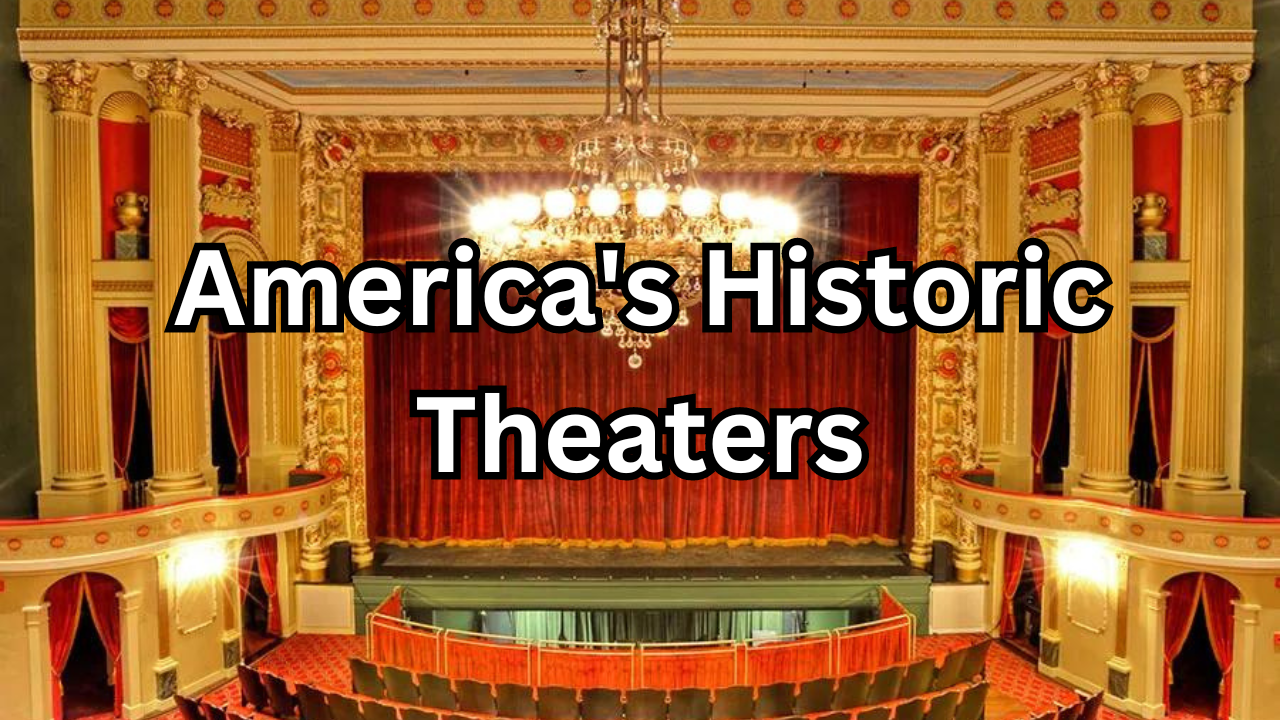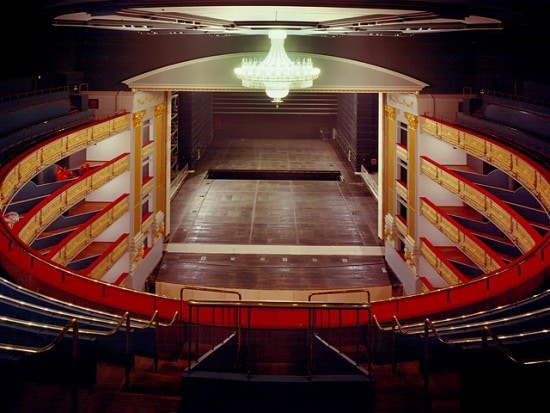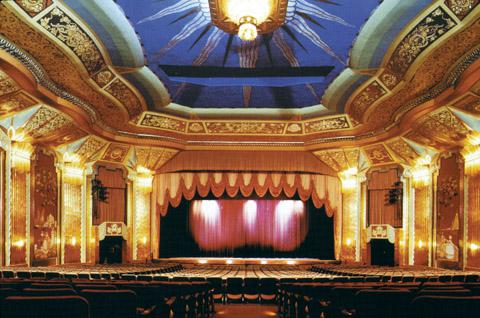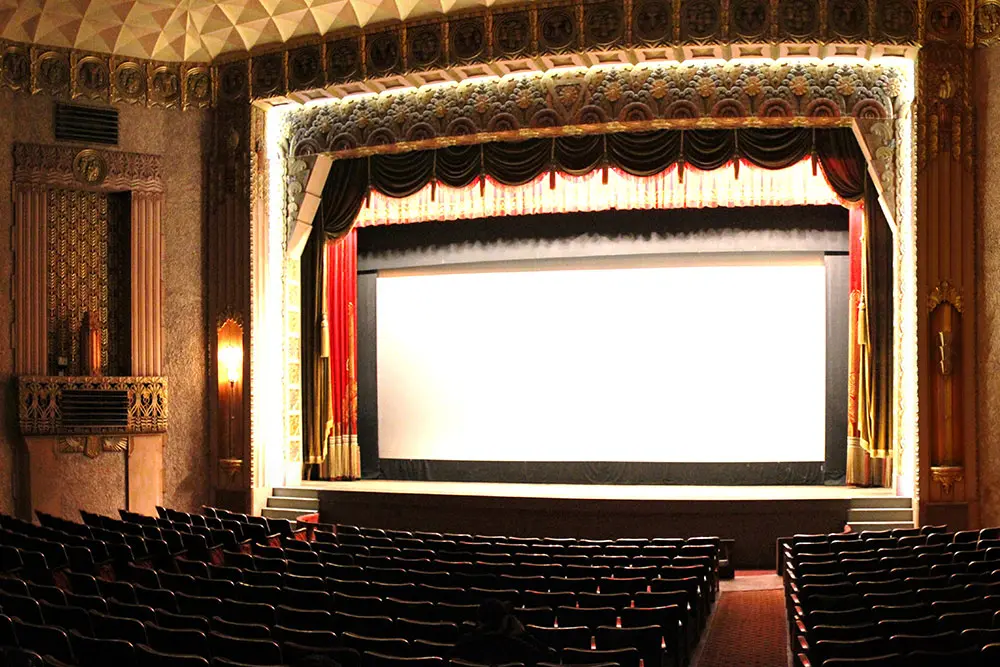
Table of Contents
Introduction
America’s historic theaters stand as vibrant testaments to the country’s rich cultural and architectural heritage. From the opulent movie palaces of the early 20th century to the intimate playhouses that first showcased local talent, these theaters have been central to the evolution of American performance art. They are not merely venues for entertainment; they are living monuments that reflect the artistic, social, and architectural trends of their times.
This tour aims to explore these cultural landmarks, offering insight into their historical significance, architectural beauty, and the role they play in preserving the arts. By delving into the stories behind these iconic theaters, we uncover a shared history that transcends time and place, highlighting how these spaces continue to impact communities and inspire future generations. Whether you’re a history enthusiast, an architecture aficionado, or simply a lover of the performing arts, join us as we journey through America’s historic theaters and celebrate their enduring legacy.
Overview of the Significance of America’s Historic Theaters Culture and History
Historic theaters in America are more than just buildings; they are cultural landmarks that encapsulate the evolution of the performing arts and the societal shifts of their times. From the grandeur of early vaudeville houses to the intricate designs of mid-century movie palaces, these theaters have served as stages for historic performances, societal commentary, and community gatherings. They reflect the architectural styles and artistic sensibilities of their eras, showcasing a blend of artistic craftsmanship and technological innovation.
These theaters played pivotal roles in shaping American culture, often becoming hubs of social and political discourse. They provided a space for both celebrated and emerging artists, influencing the development of American theater, music, and film. Additionally, many historic theaters were designed with a sense of grandeur and community spirit, emphasizing their role as gathering places for shared cultural experiences. Preserving these theaters is crucial for maintaining a tangible connection to the past, allowing us to understand and appreciate the rich tapestry of American artistic and cultural history.
Purpose of the Tour and What Readers Can Expect to Learn
The purpose of this tour is to offer a comprehensive exploration of America’s historic theaters, highlighting their architectural beauty, historical tour significance, and cultural impact. Readers will embark on a journey through some of the most iconic and lesser-known theaters across the country, discovering the stories behind their design, their role in the community, and their contributions to the arts.
Through this tour, readers can expect to gain:
- A Deeper Understanding: Insights into the historical and cultural significance of these theaters and their impact on American performing arts.
- Architectural Appreciation: An overview of various architectural styles and innovations that characterize these historic venues.
- Cultural Connections: Stories of notable performances, influential figures, and community events that have taken place within these walls.
- Preservation Efforts: Knowledge about the challenges and successes in preserving and restoring these cultural landmarks for future generations.
By the end of this tour, readers will have a richer appreciation of America’s historic theaters as more than just performance spaces—they are living artifacts that continue to shape and reflect our cultural heritage.
The Evolution of Theater Architecture

The evolution of theater architecture in America is a fascinating journey through innovation, style, and cultural shifts. From the modest beginnings of early playhouses to the opulent movie palaces of the early 20th century, and the contemporary efforts to preserve and modernize these historic spaces, theater design reflects broader trends in architecture and society.
Early Theaters and Their Design Influences
The early theaters in America, dating back to the colonial and early federal periods, were simple structures often repurposed from existing buildings. These theaters were influenced by European designs, especially those of the British and French, characterized by their modest scale and functional interiors. The architecture was straightforward, focused on practical use rather than grandeur, with basic amenities and unadorned facades.
As theater became more popular in the 19th century, designs began to evolve. The introduction of more elaborate and decorative elements reflected the growing importance of theater as a form of entertainment and cultural expression. Influences from the Victorian era, such as intricate ornamentation and the use of new materials like iron and glass, began to shape American theater design. These changes marked the beginning of a shift towards more aesthetically ambitious and architecturally significant theaters.
The Rise of the Grand Movie Palaces
The early 20th century witnessed the rise of the grand movie palaces, a period marked by architectural opulence and innovation. These theaters were designed to offer a lavish experience, blending elements of classical, Renaissance, and exotic styles to create a sense of grandeur and escapism. Architects like Thomas Lamb and C. Howard Crane led the way in designing these palatial spaces, which featured ornate facades, luxurious interiors, and state-of-the-art amenities.
Movie palaces were more than just venues for film; they were cultural landmarks that represented the height of entertainment and social status. Theaters such as the Fox Theatre in Detroit and the Grauman’s Chinese Theatre in Los Angeles became iconic symbols of the era, with their elaborate décor, massive auditoriums, and innovative lighting and sound technologies. These theaters not only transformed the movie-going experience but also set new standards for architectural design in entertainment venues.
Modern Renovations and Preservation Efforts
As time has passed, many of these grand theaters have faced challenges related to modernization, changing audience expectations, and preservation. The need to balance historical integrity with contemporary functionality has led to a variety of renovation and preservation efforts.
Modern renovations often focus on updating these theaters to meet current accessibility standards, enhance acoustics and seating comfort, and integrate new technologies while retaining their historical charm. Preservation efforts aim to protect and restore original architectural elements, such as intricate moldings, vintage lighting fixtures, and decorative murals. Organizations and local communities play a crucial role in these efforts, working to ensure that historic theaters remain vibrant and functional parts of the cultural landscape.
These renovation and preservation projects highlight the ongoing value of historic theaters as cultural treasures, bridging the past with the present and ensuring that future generations can experience and appreciate these architectural marvels.
Iconic Theaters of the East Coast
The East Coast of the United States is home to some of the most historically significant and architecturally stunning theaters in the country. Each of these theaters has its own unique story and contribution to the performing arts, making them vital cultural landmarks.
The Apollo Theater, New York City
Located in Harlem, New York City, the Apollo Theater is an iconic venue renowned for its pivotal role in the development of American music and entertainment. Opened in 1914 as the Hurtig & Seamon’s New Burlesque Theater, it was renamed the Apollo in 1934 and soon became a cornerstone of the Harlem Renaissance.
The Apollo is famous for its Amateur Night, which has launched the careers of numerous legendary performers, including Ella Fitzgerald, James Brown, and Aretha Franklin. Its Art Deco façade and distinctive interior, featuring a rich blend of African-American cultural elements, reflect its deep connection to the community and its influence on American music and entertainment.
In addition to music, the Apollo Theater has hosted a wide range of performances, from comedy to theater, making it a versatile and enduring symbol of Harlem’s cultural heritage.
The Kennedy Center, Washington D.C.
The John F. Kennedy Center for the Performing Arts, commonly known as the Kennedy Center, is a premier cultural institution located on the banks of the Potomac River in Washington, D.C. Opened in 1971, the Kennedy Center was designed by architect Edward Durell Stone and named in honor of President John F. Kennedy.
The Kennedy Center is renowned for its grand architecture, which includes a massive marble plaza and a striking modernist design. It houses several performance spaces, including the Concert Hall, the Opera House, and the Eisenhower Theater. The center is a hub for a diverse range of artistic disciplines, including classical music, opera, theater, and dance.
As a national cultural center, the Kennedy Center plays a significant role in promoting the arts and fostering an appreciation for performing arts across the country. Its annual Kennedy Center Honors ceremony, which celebrates lifetime contributions to the arts, is a highlight of its cultural contributions.
The Strand Theater, Boston
The Strand Theater, located in Boston’s Dorchester neighborhood, is a historic venue with a rich legacy of community involvement and cultural significance. Opened in 1918 as a silent movie theater, it has undergone various transformations over the decades, adapting to the changing landscape of entertainment while maintaining its historical charm.
The Strand is known for its beautiful Beaux-Arts architecture and ornate interior design, which includes intricate plasterwork and a grand chandelier. It has been a central part of Boston’s cultural life, hosting a wide range of events from film screenings to live performances.
In recent years, the theater has been a focal point for community arts programs and educational initiatives, continuing its mission to provide a space for artistic expression and cultural engagement. The Strand’s preservation and revitalization efforts highlight its importance as a cherished cultural landmark in Boston.
Historic Theaters of the Midwest

The Midwest is home to a wealth of historic theaters, each offering a glimpse into the region’s cultural and architectural evolution. These theaters have served as important venues for entertainment and community engagement, reflecting the grandeur and artistic spirit of their times.
The Chicago Theatre, Chicago
The Chicago Theatre, often referred to simply as “The Chicago,” is a quintessential example of early 20th-century opulence and design. Opened in 1921, this historic theater is renowned for its stunning Beaux-Arts architecture and its iconic marquee, which has become a symbol of Chicago’s vibrant theater scene.
Designed by architect Samuel Epstein, the Chicago Theatre features an ornate façade adorned with terracotta and intricate detailing. Inside, the theater boasts a lavish interior with rich red and gold tones, a grand staircase, and a magnificent dome ceiling. The theater was a groundbreaking venue, introducing many innovations such as air conditioning and elaborate lighting systems.
The Chicago Theatre has hosted a diverse array of performances over the decades, including vaudeville acts, film screenings, and live concerts. Today, it continues to be a major cultural landmark, hosting a variety of events and serving as a backdrop for Chicago’s dynamic arts scene.
The Fox Theatre, Detroit
The Fox Theatre in Detroit is a stunning example of the opulent movie palaces built in the early 20th century. Opened in 1928, the Fox Theatre was designed by architect C. Howard Crane and is celebrated for its lavish Persian-inspired décor and majestic ambiance.
The theater’s exterior features a grand, ornate façade with a towering marquee and intricate terra cotta detailing. Inside, the Fox Theatre’s design transports visitors to an exotic palace, complete with a magnificent chandelier, intricate ceiling murals, and plush seating. The theater’s design incorporates elements from various architectural styles, including Moorish and Byzantine influences.
The Fox Theatre has a rich history of hosting a wide range of performances, from silent films to Broadway shows. Its preservation and restoration efforts have ensured that it remains a premier venue for live entertainment and a treasured cultural landmark in Detroit.
The Ohio Theatre, Columbus
The Ohio Theatre in Columbus, Ohio, is a prime example of early 20th-century theater architecture and design. Opened in 1928 as a movie palace, the theater was designed by architect Thomas Lamb and features a grandiose interior reminiscent of a European palace.
The Ohio Theatre is known for its elaborate décor, including a stunning Spanish Baroque-style façade, ornate interior plasterwork, and a beautiful ceiling mural that depicts a starry sky. The theater’s opulent design and sophisticated acoustics made it a popular venue for films and live performances throughout its early years.
After a period of decline, the Ohio Theatre was meticulously restored in the 1970s, ensuring that its historical and architectural features were preserved. Today, the Ohio Theatre is home to the Columbus Symphony Orchestra and the Broadway in Columbus series, continuing its legacy as a vital cultural institution and cherished historic landmark.
Notable Theaters on the West Coast
The West Coast boasts some of America’s most iconic and historically significant theaters. Each venue reflects the region’s cultural dynamism and architectural innovation, offering unique experiences that highlight the artistic and architectural achievements of their times.
The Hollywood Bowl, Los Angeles
The Hollywood Bowl is an iconic outdoor amphitheater located in the heart of Los Angeles, renowned for its stunning setting and exceptional acoustics. Opened in 1922, the Hollywood Bowl has become a premier destination for live performances, particularly in the realms of classical music, jazz, and popular music.
Designed by architect Francis Marion Robinson, the Hollywood Bowl features a distinctive semi-circular shell that provides remarkable acoustics and a striking visual focal point. The venue’s open-air design allows audiences to enjoy performances under the stars, enhancing the overall experience. The bowl’s unique shape and the surrounding natural landscape contribute to its reputation as one of the most picturesque performance spaces in the world.
The Hollywood Bowl has hosted countless legendary artists and orchestras over the years, including the Los Angeles Philharmonic, and continues to be a central hub for music and cultural events in Los Angeles.
The Fox Theatre, San Francisco
The Fox Theatre in San Francisco, opened in 1929, is a prime example of the opulent movie palaces that flourished during the early 20th century. Designed by architect C. Howard Crane, the theater is renowned for its lavish interiors and grandiose architectural style, which blends elements of Spanish Colonial Revival and Mediterranean influences.
The theater’s exterior features a grand marquee and a richly detailed façade, while the interior boasts an elaborate design that includes intricate plasterwork, a grand chandelier, and a starry sky ceiling. The Fox Theatre was initially built to showcase films and live performances, and it became one of San Francisco’s premier venues for entertainment.
Despite its initial closure in the 1960s, the Fox Theatre has been restored and is now an important part of San Francisco’s cultural landscape. It continues to host a variety of performances, including concerts and theatrical productions, preserving its legacy as a historic and architectural gem.
The Paramount Theatre, Seattle
The Paramount Theatre in Seattle is a historic and architecturally significant venue that opened its doors in 1928. Designed by architect B. Marcus Priteca, the theater is known for its lavish Art Deco design and its role as a prominent entertainment venue in the Pacific Northwest.
The Paramount Theatre features a stunning façade with intricate detailing and a grand marquee that captures the spirit of the era. Inside, the theater’s opulent design includes a richly decorated auditorium with a striking ceiling that evokes the night sky, and elegant detailing throughout the space.
Originally built as a movie palace, the Paramount Theatre has evolved to become a leading venue for a wide range of performances, including Broadway shows, concerts, and film screenings. Its preservation and ongoing role in the arts make it a cherished cultural landmark in Seattle, celebrating both its historical significance and its continued relevance in the performing arts community.
Southern Gems and Their Stories
The Southern United States is home to a variety of historic theaters that embody the region’s rich cultural heritage and architectural elegance. These theaters have served as important cultural and community hubs, each with its own unique story and significance.
The Fox Theatre, Atlanta
The Fox Theatre in Atlanta is one of the South’s most celebrated and architecturally stunning venues. Opened in 1929, the theater was designed by architect C. Howard Crane and is renowned for its elaborate Arabian Nights-inspired décor. Its grand façade, featuring intricate terra cotta detailing and a towering marquee, sets the stage for the opulent experience inside.
The interior of the Fox Theatre is equally impressive, with its lavish décor including a soaring ceiling designed to mimic the night sky, ornate chandeliers, and elaborate plasterwork. The theater originally served as a movie palace and was a center for vaudeville performances. Over the years, it has hosted a wide range of events, including Broadway shows, concerts, and film screenings.
The Fox Theatre’s restoration and preservation efforts in the 1970s have ensured that it remains a vibrant part of Atlanta’s cultural landscape. Its rich history and architectural beauty continue to attract visitors and artists from around the world.
The Saenger Theatre, New Orleans
The Saenger Theatre in New Orleans, opened in 1927, is a magnificent example of the opulent movie palaces built in the early 20th century. Designed by architect Emile Weil, the Saenger features a striking Beaux-Arts façade and an elegant interior that reflects the grandeur of the era.
The theater’s interior is adorned with lavish detailing, including a grand chandelier, intricate plasterwork, and a beautifully painted ceiling that evokes the feeling of being outdoors under a starlit sky. The Saenger Theatre has played a significant role in the cultural life of New Orleans, hosting a wide variety of performances from Broadway productions to classical music concerts.
After a period of decline, the Saenger Theatre underwent a major restoration in the early 2000s, restoring its historic charm and ensuring that it continues to be a central venue for arts and entertainment in New Orleans. The theater remains a symbol of the city’s vibrant cultural heritage and a cherished venue for both locals and visitors.
The Bijou Theatre, Knoxville
The Bijou Theatre in Knoxville, Tennessee, opened in 1909, is a historic gem known for its early 20th-century design and its role as a community gathering place. Designed by architect J. B. McElfatrick, the Bijou features a charming façade and an intimate auditorium with a classic early cinema atmosphere.
Originally a vaudeville theater, the Bijou has been an important venue for various forms of entertainment, including film screenings, live performances, and community events. Its quaint size and vintage charm offer a unique experience compared to larger, more modern venues.
The theater’s preservation efforts have focused on maintaining its historical character while adapting to contemporary needs. Today, the Bijou Theatre remains a beloved part of Knoxville’s cultural scene, continuing to host a diverse range of performances and serving as a nostalgic link to the city’s entertainment history.
Lesser-Known Historic Theaters Worth Visiting

While many historic theaters are well-known landmarks, there are several lesser-known venues across the United States that offer unique architectural beauty and rich cultural histories. These theaters, though perhaps not as widely recognized, provide a glimpse into the diverse heritage of American performing arts and continue to serve as vital cultural hubs.
The Majestic Theatre, Dallas
The Majestic Theatre in Dallas, Texas, is a charming example of early 20th-century theater architecture and design. Opened in 1921, the Majestic was designed by architect John Eberson and is renowned for its atmospheric design, which creates the illusion of an outdoor garden setting.
The theater’s exterior is characterized by its Spanish Revival style, featuring decorative tilework and a grand marquee. Inside, the Majestic’s design includes a beautifully detailed auditorium with a ceiling that mimics a starry night sky, along with lush, intricate ornamentation that evokes a sense of opulence and grandeur.
Originally a movie palace, the Majestic Theatre has evolved to host a variety of performances, including concerts, theater productions, and community events. Its historical significance and well-preserved design make it a noteworthy destination for those interested in classic American theater architecture.
The Grand Theatre, El Paso
The Grand Theatre in El Paso, Texas, is a historic venue that reflects the cultural and architectural influences of the early 20th century. Opened in 1929, the Grand Theatre was designed by architect Henry C. Houghton and features a striking Beaux-Arts style façade with intricate detailing and an elegant marquee.
Inside, the theater is known for its beautifully preserved Art Deco interior, which includes ornate plasterwork, a grand chandelier, and a richly decorated auditorium. The Grand Theatre originally served as a movie palace and a venue for live performances, and it has been an important part of El Paso’s cultural life for decades.
Efforts to restore and preserve the Grand Theatre have ensured that it remains a vibrant part of the local arts scene. It continues to host a range of events, including film screenings, live performances, and community gatherings, making it a valuable cultural landmark in El Paso.
The Orpheum Theatre, Memphis
The Orpheum Theatre in Memphis, Tennessee, is a historic venue with a rich legacy of entertainment and architectural elegance. Opened in 1928, the Orpheum was designed by architect C. Howard Crane and is known for its luxurious Beaux-Arts design and opulent interior.
The theater’s exterior features a grand marquee and ornate façade, while the interior boasts a lavish design with intricate plasterwork, elegant chandeliers, and a beautifully decorated ceiling. The Orpheum Theatre was originally built as a movie palace and vaudeville theater, and it has played a significant role in Memphis’s cultural history.
After undergoing a major restoration in the 1970s, the Orpheum Theatre continues to be a premier venue for Broadway shows, concerts, and other live performances. Its historical charm and ongoing contributions to the arts make it a must-visit destination for theater enthusiasts and those interested in the rich cultural heritage of Memphis.
The Role of Theaters in Community and Culture
Theaters have long been central to the cultural and social fabric of communities across the United States. They serve as more than just venues for performance; they are vital cultural hubs that foster community engagement, artistic expression, and historical preservation.
Theaters as Cultural Hubs and Community Gathering Spaces
Theaters have historically played a significant role as gathering spaces where communities come together to share experiences and engage with the arts. These venues offer a unique space for collective enjoyment and dialogue, providing a platform for diverse artistic expressions and cultural events. From local performances to major productions, theaters bring people together, creating a sense of shared experience and cultural identity.
Many theaters host a variety of events beyond traditional performances, including community meetings, film festivals, and educational programs. This versatility enhances their role as community hubs, fostering connections among residents and promoting cultural enrichment. Theaters often serve as focal points for community celebrations and cultural events, reflecting and reinforcing local traditions and values.
Moreover, theaters can act as catalysts for community development and revitalization. Their presence in a neighborhood often stimulates economic activity, attracts tourism, and supports local businesses, contributing to the overall vitality and attractiveness of the area.
Impact on Local Arts and History
Theaters have a profound impact on local arts and history by providing a platform for artistic expression and preserving cultural heritage. They offer opportunities for local artists to showcase their work, whether through performances, exhibitions, or other artistic endeavors. By supporting local talent, theaters contribute to the development of the regional arts scene and foster a vibrant cultural landscape.
Additionally, historic theaters often serve as living museums that preserve and celebrate the architectural and cultural history of their communities. Their preservation efforts help maintain the architectural integrity and historical significance of these venues, allowing future generations to experience and learn about the past.
Theaters also play a role in documenting and reflecting the social and cultural history of their regions. Through their programming and performances, they capture and convey the stories and experiences of the local community, contributing to a richer understanding of the area’s heritage.
In essence, theaters are integral to the cultural and historical fabric of their communities. They provide spaces for artistic expression, foster community connections, and preserve the historical and cultural legacy of their regions, ensuring that the arts continue to thrive and evolve within their local contexts.
Preservation and Restoration Efforts
Preservation and restoration of historic theaters are crucial for maintaining their cultural and architectural significance. These efforts ensure that these venues continue to serve as vibrant parts of their communities while honoring their historical legacy. However, preserving such landmarks comes with its own set of challenges and requires thoughtful and effective solutions.
Challenges in Maintaining Historic Theaters
Maintaining historic theaters involves several challenges, primarily related to the building’s age, evolving safety codes, and the need for modern amenities.
- Aging Infrastructure: Many historic theaters face issues related to aging infrastructure, including outdated electrical systems, deteriorating structural elements, and outdated plumbing. Addressing these problems while preserving the building’s historical integrity can be complex and costly.
- Compliance with Modern Standards: Historic theaters often need to be updated to meet current safety codes and accessibility standards, such as installing ramps, elevators, and fire suppression systems. Balancing these updates with the need to preserve historical features requires careful planning and design.
- Financial Constraints: Restoration and preservation projects can be expensive, often requiring significant funding from a combination of public grants, private donations, and fundraising efforts. Securing the necessary financial resources can be a major hurdle, particularly for smaller or less well-known theaters.
- Maintenance of Authenticity: Ensuring that modern updates do not compromise the historical authenticity of the theater is a delicate process. Restorers must carefully select materials and techniques that match the original design while integrating necessary modern improvements.
Examples of Successful Restoration Projects
Despite the challenges, several historic theaters have undergone successful restorations, serving as models for preserving cultural heritage while adapting to contemporary needs.
- The Chicago Theatre, Chicago: The Chicago Theatre, originally opened in 1921, underwent a major restoration in the 1980s. The restoration preserved its stunning Beaux-Arts façade and intricate interior details while updating the venue with modern amenities. The project revitalized the theater as a leading cultural venue and a symbol of Chicago’s architectural heritage.
- The Saenger Theatre, New Orleans: The Saenger Theatre, which opened in 1927, experienced a significant restoration following Hurricane Katrina’s devastation. The project, completed in 2013, meticulously restored the theater’s Beaux-Arts design, including its ornate plasterwork and grand chandelier. The successful restoration revitalized the theater as a central part of New Orleans’ cultural scene, demonstrating resilience and commitment to preserving historic landmarks.
- The Fox Theatre, Atlanta: The Fox Theatre in Atlanta, which opened in 1929, underwent extensive restoration efforts in the 1970s. The project focused on preserving its lavish Arabian Nights-inspired décor while addressing modern needs such as updated seating and improved acoustics. The restoration was a key factor in the theater’s continued prominence as a cultural and entertainment hub in Atlanta.
These examples illustrate the potential for successful preservation and restoration of historic theaters. Through careful planning, community support, and a commitment to maintaining historical integrity, these projects not only restore the physical spaces but also ensure that the cultural and artistic legacy of these theaters endures for future generations.
Conclusion
Historic theaters are more than just buildings; they are living monuments to the rich cultural, artistic, and architectural history of their communities. From the grand movie palaces of the early 20th century to the intimate playhouses that nurtured local talent, these theaters offer a unique glimpse into the evolution of American entertainment and society.
As we’ve explored, the significance of these theaters extends far beyond their physical structures. They serve as cultural hubs, providing spaces for shared experiences and artistic expression while fostering community connections. Their impact on local arts and history is profound, preserving stories and traditions that might otherwise be lost.
The challenges of preserving and restoring these historic venues are considerable, from addressing aging infrastructure to balancing modern needs with historical authenticity. However, successful restoration projects demonstrate that with dedication, creativity, and community support, it is possible to revitalize these theaters while honoring their legacy.
In celebrating the stories of historic theaters, we not only recognize their architectural beauty and historical significance but also reaffirm their role in shaping and enriching our cultural landscape. By supporting ongoing preservation efforts and appreciating the stories they tell, we ensure that these treasured landmarks continue to inspire and engage future generations.
As we conclude our tour of America’s historic theaters, we invite you to visit these remarkable venues, appreciate their unique histories, and celebrate their enduring contributions to the arts and community life.
Recap of the Cultural Importance of These Landmarks
Historic theaters are more than just architectural marvels; they are vital cultural landmarks that embody the artistic and social history of their communities. These theaters have served as stages for transformative performances, centers of cultural exchange, and symbols of artistic innovation throughout the years. They reflect the diverse architectural styles and technological advancements of their eras, offering a tangible connection to the past.
Their significance extends beyond their historical and aesthetic value. These theaters act as communal spaces where people come together to experience shared moments of creativity and expression. They play a crucial role in preserving local traditions, supporting emerging artists, and fostering a sense of cultural identity. By celebrating and preserving these theaters, we honor the rich legacy they represent and ensure that future generations can continue to engage with and learn from these cultural treasures.
Call to Action for Supporting and Preserving Historic Theaters
As we recognize the profound cultural importance of historic theaters, it is essential that we take proactive steps to support and preserve these invaluable landmarks. Here’s how you can contribute to their preservation:
- Support Preservation Efforts: Contribute to local preservation organizations, foundations, and theater restoration projects. Financial support, whether through donations or fundraising events, plays a crucial role in ensuring that these theaters receive the necessary resources for maintenance and restoration.
- Get Involved Locally: Volunteer your time or skills to help with theater events, community outreach, or restoration projects. Many theaters rely on community volunteers to assist with various aspects of their operations and preservation efforts.
- Attend Performances and Events: Support historic theaters by attending their performances, screenings, and events. Your participation not only helps sustain the theater financially but also underscores its importance as a vibrant cultural hub.
- Advocate for Preservation: Raise awareness about the value of historic theaters within your community and advocate for their protection. Engage with local government officials and support policies that promote the preservation of cultural landmarks.
- Share the Story: Spread the word about the significance of historic theaters through social media, local media, and community groups. Highlight their contributions to cultural heritage and encourage others to take an active role in their preservation.
By taking these actions, we can help ensure that historic theaters continue to thrive and inspire future generations. Let us all commit to preserving these cultural gems and celebrating the rich artistic and historical legacy they represent.






